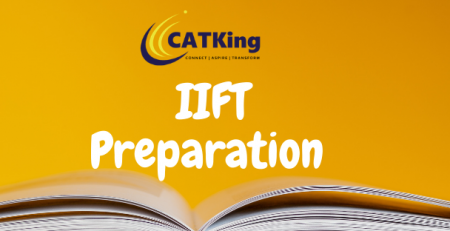IIFT difficulty level
IIFT difficulty level and how to ace it
IIFT exam is the written admission test for a two-year Management course at The Indian Institute of Foreign Trade. It comes under the umbrella of leading business schools in India. The institute has gathered fame for its International Business and Management courses. IIFT doesn’t accept CAT scores but rather prefers to conduct a separate entrance test for selecting its candidates. IIFT difficulty level is pretty much the same every year. After clearing the first round based on marks obtained in the written test, the candidates are further called for the next level which is comprised of essay writing, group discussions, and interviews. The additional General awareness section is something that makes the IIFT exam more difficult to crack. But if you are well aware of the IIFT difficulty level, you can ace the IIFT exam.
IIFT difficulty level: Is it easy or difficult?
The IIFT difficulty level is usually easy to moderately difficult. The level of questions is certainly low as compared to the cat. The questions are mixed. There are always basic sitter questions that you can solve in 10 to 15 seconds. Your calculation speed matters a lot when it comes to IIFT. You might come across some calculation intensive questions that end up taking a lot of time. Such types of questions are mostly found in data interpretation. Sometimes in reading comprehension, there is one such passage always present that is meant to be solved in the end because it is lengthy and difficult to interpret.
This makes the passage a lot of time-consuming. You will develop a nack of recognizing the difficulty level of a particular question the more and more you practice. It is highly advisable for you to solve the exam in 2 rounds. In round 1 you attempt all the easy level questions and in the second round, you solve the remaining ones. This strategy will ensure that you don’t miss out on questions that are direct and formula-based. This strategy, is applicable to all the sections.
The pattern of the IIFT admission exam is as follows:
- IIFT is conducted in online mode from the year 2019. Now IIFT is a computer-based exam.
- The duration of the exam is 2 hours
- There is a change in the pattern of the IIFT exam every year. The number of questions varies between 120 and 150.
- The questions are in the format of the multiple-choice questions.
- The IIFT question paper consisted of questions from the following areas: English comprehension, General Knowledge & Awareness, Logical Reasoning, Quantitative Analysis.
There is no sectional time limit in the IIFT exam. You can pick the sections to solve in the order of your choice. Keeping the difficulty level of IIFT in mind, if you have a proper strategy in place, you can definitely crack the exam. There is a sectional cut off for every section that you have to meet in order to be eligible for securing calls for the further admission process. The IIFT paper is said to be tougher than CAT and the success in this exam depends on the candidate’s time management skills and extreme practice in solving multiple choice type questions. Attempting maximum standard questions in less than 8- seconds per question is the mantra of excellence in the exam. The test also has a history of recreating CAT exam questions.
Read: Tips to crack IIFT
The IIFT exam primarily asks questions on five areas: Quant, DI, Logical Reasoning, VA, and GK. The negative marking is 1/3rd. The details of the IIFT exam is as follows:
Quantitative Aptitude
- Arithmetic: Ratio Proportion, Percentages, Average
- Other topics like Time speed distance, time and work, mixture allegation, profit and loss
- Geometry
- Mensuration
- Geometric Mean
- Harmonic Mean
- Mean
- Median
- Mode
- Standard Deviation
In the IIFT difficulty level of the quantitative ability, the section is easy to moderately difficult. In order to prepare for the quantitative ability section, you first need to get through with your basics. Once you are thorough with the concepts, you can start with solving the basics from the study material of any coaching classes. If you don’t have it the best resource to start with would be RS Aggarwal or Arun Sharma. You don’t need to solve the level of difficulty -3 of the Arun Sharma book. Be fluent with the questions from the level of difficulty 2 and you are ready to ace the quantitative ability section of the IIFT exam. You need to keep revising the old topics when you solve the new ones or you might lose touch.
The best way to keep up with all the topics of the quantitative ability section is to attempt topic wise tests daily. Nonengineers usually tend to have a difficult time while solving questions from the quantitative ability. If they follow this particular strategy they should not have a problem.
Read: How to crack quants
Data Interpretation
- Line
- Bar
- Pie graphs
- Tables
- Number problems
Read: Brilliant speed calculation techniques
Analytical/Logical Reasoning
- Decision Making
- Data Structures
- Series
- Coding-Decoding
- Blood relations
- Alphabetical Series
- Verbal Logic
- Syllogisms
The Logical reasoning section in the IIFT is also said to be easy to moderately difficult. The syllabus is entirely different for the cat so you have to prepare separately for the logical section. This section also carries a perfect blend of easy and difficult questions.
Read: Tips to improve logical reasoning
Verbal Ability
- Grammar
- Para-Jumbles
- Vocabulary-based Questions
- Reading Comprehension
The Verbal sections are divided into two major parts; Reading Comprehension and English Usage. The RC has good weightage so, this can make or break your scores in the verbal section. Vocabulary is very important since if your vocab is not strong, you would fail to quickly answer some of the easy questions. IIFT has 4-5 questions on vocabulary. If you prepare well for it, you get 4 to 5 marks in your pocket straight away.
Read: How to prepare for verbal ability section
General Knowledge/Current Awareness:
This section carries approximately 15% weightage of your total score. There is no outlined syllabus for GK. One needs to regularly follow top news stories, General Awareness questions, and editorials. As per last year’s trend, it is observed that in the general awareness section, there are more questions asked on current affairs as compared to the static GK questions. In the general awareness section, you can expect the questions to come from, Politics, Business, Society, Economics, Banking, History, and dramatics backgrounds. You can refer to various applications from play store that update current affairs on a regular basis.
Also read: Gear up for the GK section in the IIFT exam
The study material for the IIFT exam:
The mentors at Catking have curated the study material for MBA entrance exams in a systematic manner. It is divided into three phases: basic, advance, and intensive. These books can help you build your foundation for your basic concepts. Secondly, Once you are thorough with your basics, you can move on to solve the questions from the advanced level books. After the advanced books, you can start with the intensive level with are actual exam level questions. If you are thorough with these materials, you can easily tackle any question that comes your way, no matter what the difficulty level. There is no dedicated study material for the IIFT exam. If you are preparing for other competitive exams like CAT, NMAT, Snap, etc you are prepared for IIFT as well. Apart from the GK section, other sections and the syllabus for the IIFT exam is pretty much the same.
Conclusion:
To summarize the overall difficulty level of the IIFT exam, Data Interpretation is calculation-intensive and has huge tables that take up a lot of time. Secondly, Logical reasoning and Verbal Ability are moderately difficult while the questions are easier as compared to CAT. Thirdly, When it comes to reading comprehension in the IIFT exam, it is observed that the passages are from specific genres, like political science. They are tedious and questions are related to fact-finding. Moreover, Time constraints are present and also require logic. The passages are time-consuming as the language in the passages is of a high level and takes time to interpret. It mainly consists of heavy words. If you do not know the meaning of a certain word, you might get stuck.
But if you are someone who is an avid reader and with a strong vocabulary, you can comfortably ace the IIFT exam. GK focuses on business awareness with a few static questions and general awareness questions.
I hope you like this article and it helps you gain some insights regarding the difficulty. All the best!

















